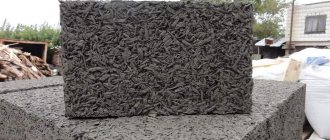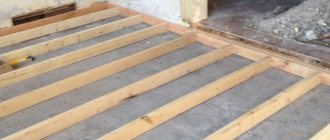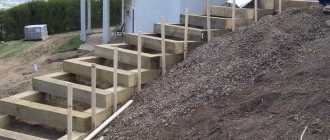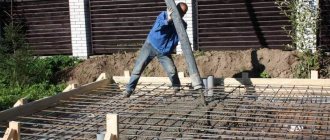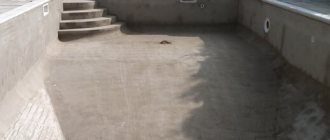Reinforced concrete wells are standard structures that are assembled from special elements: as a rule, they include a bottom, cylindrical wall rings, covers made of concrete and steel reinforcement, and steel hatches. Wells are used in a variety of areas - they are used in the installation of various communications.
The main purpose of reinforced concrete wells is to create buried structures intended for operation above/below the groundwater level in conditions of non-aggressive/slightly aggressive waters. Reinforced concrete wells are used in residential, industrial, and road construction; they are relevant for organizing heating and utility networks, and sewer pipelines.
Elements for assembling wells are produced in accordance with GOST 8020-90 from heavy concrete reinforced with a steel frame. A standard well consists of 3-4 elements, but, depending on the purpose and functions, there may be more. All structural parts correspond to standard dimensions, volumes, and technical characteristics.
The main advantages of reinforced concrete wells:
- The strength of all products - reinforced concrete is able to withstand high loads from soil pressure, and due to its dense structure, a sewer or water well is not afraid of erosion and groundwater pressure.
- The ability to use such wells in almost all types of soil.
- The smooth surface of the concrete prevents dirt from clinging to it, reducing the risk of blockages. Concrete is easy to clean and does not require the use of special equipment or the involvement of qualified craftsmen.
- Long service life - a prefabricated well installed using technology and based on correct calculations can last for decades, maintaining the strength characteristics and integrity of the entire system.
- Ease and simplicity of installation and repair - all elements of the well correspond to standard dimensions, according to the markings it is easy to match one to the other, and if necessary, you can simply replace one of the parts without changing the entire system.
- Environmentally friendly and safe - concrete does not emit toxins, does not pollute the environment and the water inside.
Why do you need to protect wells from water?
Figure 1. Waterproofing a well made of concrete rings. An
underground concrete structure is affected by many negative factors, so without specific protection it can quickly become unusable. The need for waterproofing wells is dictated by the following reasons:
- If concrete absorbs moisture, then at negative temperatures it begins to expand. In this case, the ring becomes covered with cracks and eventually completely collapses.
- Contaminated perched water may enter the well excavation. At the same time, drinking water becomes cloudy, and the source itself dies.
- If the joints between the concrete rings are not sealed, groundwater will flow into the sewer well, overflowing it. In this case, the nearby soil becomes contaminated with runoff and becomes unusable.
- Washing out compounds for insulating joints. Even the smallest trickle becomes larger over time. If repair measures are not taken, the structure will collapse.
Water from the well can flow beyond its boundaries, which leads to subsidence of the soil. In this case, the structure warps and falls apart. To avoid such negative consequences, timely waterproofing of concrete rings and their joints must be carried out.
How to choose the type of hydraulic structure
Wells have several advantages over wells, and many property owners find them very convincing:
- Price. The cost of building a well is lower than drilling a well. If the owner is sure that he can equip a concrete well with his own hands, then this automatically reduces costs to a minimum, because You won’t have to pay for the services of a team of workers.
- Ease of use. This is a universal hydraulic structure from which you can obtain water in any convenient way: using a bucket or pumping out water with a manual, electric surface, or submersible pump. If necessary, you can easily change the methods of water supply at home.
- No hassle with document approval. Permission from the competent authorities is required only for drilling artesian wells. If we are talking about a well, there is no need to fill out any paperwork.
Well on the site
The choice of design comes down to the two most common options - shaft and tube wells. To build a tubular structure (so-called column), special drilling equipment is required. If it is available, then you can install a column. And if, of all the “high technologies” on the site, only a shovel is available, then there is no choice at all; you will have to dig a mine well. It is quite possible to equip it on your own.
Monolithic shaft well
Specifics of additional processing
Waterproofing performs different functions depending on the purpose of the wells. However, it always serves to ensure that liquid does not penetrate through the concrete rings in both directions.
Drinking source
In the absence of waterproofing, clay, sand, chemicals, and pathogenic microorganisms enter the drinking source along with groundwater. When drinking such liquid, the likelihood of poisoning and the development of various diseases increases. In addition, the source of drinking water itself may become clouded and become unusable without the possibility of its restoration.
Wastewater
All wastewater that enters the sewer well must be treated before entering the ground. They contain pathogenic microorganisms, chemicals, and dangerous organic compounds. If polluted water gets into the soil, it will harm not only plants, trees and animals, but also people.
Updating the insulating layer
Measures for waterproofing concrete wells from rings are planned at the design stage of the structure. However, during operation this layer can lose its properties. The tightness of the structure deteriorates. In this case, updating the waterproofing layer is required. Repeated work is carried out if the well is overfilled with sewage, or impurities have appeared in the drinking water. In these cases, updating the waterproofing is required both inside and outside.
Selecting a location
Before you start digging a hole for a future water source, you need to select a site for it. This should be an environmentally friendly place, located away from roads (highways), gas stations, factories, cesspools, and other areas that do not meet sanitary requirements.
Important detail : The place for the water source must be located in such a way that it is convenient to approach it. To find out how much it will cost to build a well, you need to find out at what level the groundwater layer is (you can ask your neighbors).
External waterproofing of a well made of concrete rings
Waterproofing for a well made of concrete rings must be carried out in compliance with all technological nuances. The wrong choice of material or its incorrect application makes the layer ineffective.
Figure 2. Installation of waterproofing of a well made of concrete rings
Preparing an existing well for waterproofing
The structure requiring protective measures should not contain liquid, so it is first dried. Additionally, the well is covered to prevent precipitation from falling on it. You can begin work as soon as the moisture stains have disappeared from the concrete rings.
The surface of the structure must be cleaned of sand, soil and other contaminants. If there are areas of loose concrete, they need to be removed. If reinforcing bars are exposed, they must be covered with concrete mortar. To improve the adhesion of the sealant, the joints, as well as existing cracks, are deepened by 2-3 cm and widened to 2 cm.
Bitumen-based waterproofing
Bitumen compounds are widely used for waterproofing wells made of concrete rings, as they are resistant to temperature changes and are not destroyed by pressure moisture. To improve the characteristics of the material, polystyrene or polyurethane is introduced into its composition. He has the following qualities:
- softens at a temperature of 80 degrees and sets at -10 degrees;
- good adhesion not only to dry, but also to wet surfaces;
- ease of use (the substance can be applied with a brush or spray);
- high hardening rate, since the material contains 65% volatile substances;
- low level of water absorption (up to 0.4% per day).
Bitumen compounds for waterproofing concrete rings are the most effective, but it is prohibited to use it for treating the inner surface of drinking wells. The isolation process involves the following stages:
- Surface treatment with primer. The presented substance strengthens the concrete surface and improves adhesion to protective materials.
- Treating joints with rubber tape.
- Sealing cracks and seams with cement-sand mixture. Additionally, PVA glue is introduced into it.
- Re-priming the surface.
- Applying mastic. The layer should be uniform. The composition is applied several times. Each previous layer must dry.
- Fixing roll material.
The seams are additionally coated with mastic. The final stage of external waterproofing is the arrangement of the blind area.
Penetrating compounds
Deep penetration waterproofing is an alternative to coating compounds. In order for it to perform its function well, it is not necessary to pre-prime the concrete rings. The product is applied to the surface twice, and it is not necessary to wait for the previous layer to dry completely. After using the impregnation, the structure must dry for 3 days.
Once inside the concrete, the penetrating composition crystallizes. It clogs micropores inside the material and prevents it from absorbing moisture. In this case, additional protective measures may not be used.
Clay castle for drinking well
The clay castle protects the well from surface water that flows down its walls. Such protection will prevent dirty liquid from entering the aquifer. To provide insulation, a layer of clay is applied along the outer perimeter of the structure. It is best to carry out the procedure in late spring, after the soil has subsided. Work is carried out in dry weather.
To do this, a trench 2-3 m in size is dug around the concrete rings. The fertile part of the soil must be removed. The rest of the soil is compacted. This creates a slight slope towards the well. The clay mixture should have the consistency of viscous, tight plasticine. It is cleaned of impurities of sand and stones. A layer of clay must be laid and compacted. Its thickness is 15 cm.
Blind area
The blind area is being built to protect the clay castle. Usually it is monolithic, but it is allowed to make it from tiles. The first option cannot be used until the soil completely shrinks, which occurs within 2-3 years.
General stages of laying a blind area
Regardless of the material that will be used to construct the blind area, its organization scheme is simple. After the soil has settled, a working space is cleared around the well shaft and a trench is dug. The depth depends on the type of protective structure, and the diameter for hard and soft blind areas is almost the same.
The trench is filled with clay, cement mortar or bulk material, the surface is leveled and prepared for further finishing at the request of the owner. After construction work, you need to monitor the blind area in order to notice the appearance of damage in time.
Waterproofing the inside of the well
Figure 3. Internal waterproofing of a well made of concrete rings
Waterproofing on the inside of the well is carried out depending on the nature of the damage to the concrete rings and the degree of destruction of the joints. The process is carried out in accordance with building codes and standards.
Sequence of work inside
To begin with, materials, tools and the surface of the well are prepared. The concrete base is thoroughly cleaned of mule, dirt, and mortar residues. If the reinforcement is exposed, it must be cleaned and treated with an anti-corrosion compound. Small cracks widen and deepen. Recesses and chips are sealed with a cement-sand mixture or a ready-made repair compound.
Before applying waterproofing, concrete surfaces are treated twice with a deep penetration primer. After it has dried, you can begin to apply the insulating material. It is better to use a penetrating type of protection inside the well. It is applied to slightly moistened concrete. For work, a brush is used. First, apply 1 layer, and a day later the second. The treated surface can be used after 3-7 days.
Waterproofing of septic tanks and technological wells
If the septic tank for collecting wastewater is multi-chamber, then the waterproofing process is not carried out on the filtration well. Through it, the purified liquid enters the ground. The remaining parts of the sewer system require good insulation. The technology for processing structures is no different from previous cases.
Figure 4. Waterproofing a well made of concrete rings
Processing of joints
Since many rings are used to construct a well, it is natural that there will be joints between them. They are the ones who are vulnerable to the effects of water. They need to be coated with bitumen mastic and covered with protective tape on the outside during the construction stage. The inside of the connections is treated with a repair compound that will not pollute the water or harm humans.
If the well is operational, then those joints that are above the water level need to be sealed. Waterproofing is applied in parts of 15-20 cm. Puttying of vertical joints is carried out from the bottom up. If water breaks through the joint, then the insulator is laid as follows:
- 25 cm below the connection, 2 holes of 2-2.5 cm in diameter are drilled so that the flow of groundwater can be redirected;
- the hole is processed, and the mixture should fill the joint by 70%;
- the seal is fixed manually for 2-3 minutes;
- the drainage holes are clogged with wooden plugs or rubberized tow.
The bottom filter is cleaned last. If necessary, it is changed.
Processing of pipes and transitions
Wastewater wells consist of several structures. In one, the slurry settles, in the rest, the liquid is filtered. Since these parts are connected to each other by transitions, their waterproofing also needs to be given due attention. A special cord is required for insulation. It fills the joints, after which these places are sealed with cement mortar containing polymers. Before carrying out the procedure, the structures must be cleaned and dried.
The pipes themselves are pre-treated with a primer and then covered with bitumen mastic. This will require 2-3 layers. If roll material is used for work, then preference is given to bitumen-polymer tapes.
Waterproofing a well consisting of concrete rings is an important stage in the construction of a structure. In order for the protection to be effective, the structure must be treated at the stage of primary construction. However, over time, it loses its functions under the influence of negative factors, so the surface insulation procedure is repeated periodically.
Dangers of quicksand
The main danger factor of quicksand manifests itself during direct excavation of the soil. The quicksand in the well is under high pressure, so if the work is done manually, the pressure can wash away not only the rings themselves, breaking the reinforced concrete, but also take the lives of workers.
Otherwise, if digging a well on quicksand is carried out safely, but in the process a leak appears through the reinforced concrete wall, then the main danger is considered to be water contamination, since it is no longer suitable for drinking or for domestic needs.
Among the positive aspects of this natural phenomenon, one can highlight the fact that when the quicksand is near the well and completely safely affects its walls, then the melt water, passing through the quicksand filter, is further purified.




